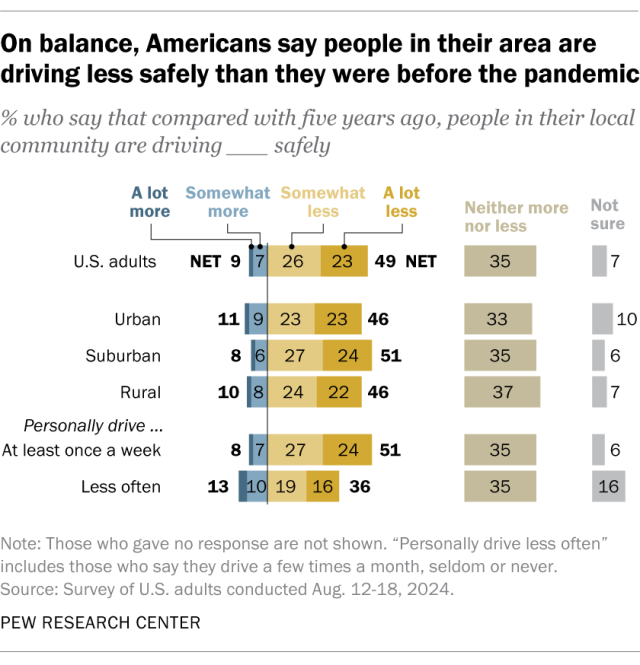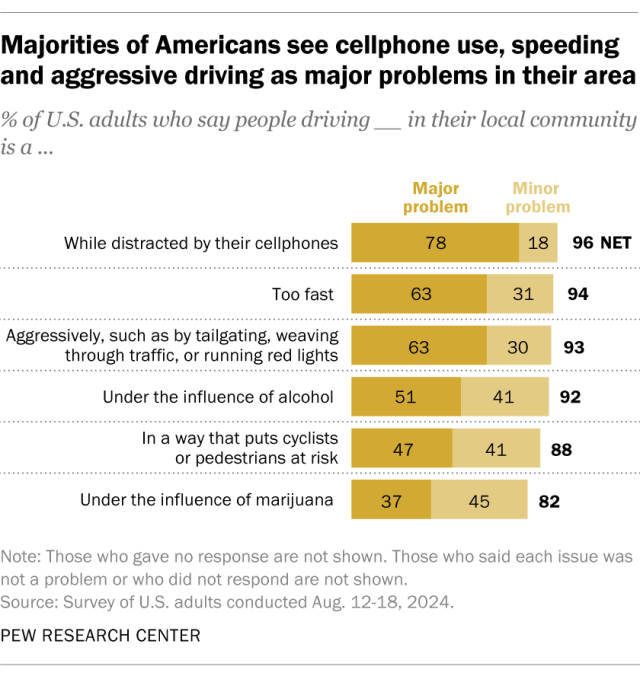
As millions of Americans prepare to hit the road for holiday travel, many U.S. adults feel that driving in their area has become more dangerous than it was before the coronavirus pandemic. Most see cellphone distraction behind the wheel as a major problem in their local community, and about a quarter report witnessing road rage often, according to a new Pew Research Center survey.

While the pandemic-era spike in the number of fatalities from vehicle crashes in the United States has abated some, 49% of Americans today say people in their community are driving less safely compared with five years ago. This includes 23% who say people in their area are driving a lot less safely.
A far smaller share (9%) say driving behaviors in their area have become safer. Another 35% don’t see a change in people’s driving habits.
Pew Research Center conducted this analysis to examine how Americans view driving habits in their community and whether these habits have changed in recent years. For this analysis, we surveyed 5,410 U.S. adults from Aug. 12 to 18, 2024.
Everyone who took part in this survey is a member of the Center’s American Trends Panel (ATP), a group of people recruited through national, random sampling of residential addresses who have agreed to take surveys regularly. This kind of recruitment gives nearly all U.S. adults a chance of selection. Surveys were conducted either online or by telephone with a live interviewer. The survey is weighted to be representative of the U.S. adult population by gender, race, ethnicity, partisan affiliation, education and other factors. Read more about the ATP’s methodology.
Here are the questions used for this analysis, the topline and the survey methodology.
Some people are more likely than others to perceive an uptick in dangerous driving in their area:
- 51% of Americans who personally drive at least once a week say people are driving less safely today, compared with 36% of those who drive only a few times a month or less often.
- Americans living in suburban areas (51%) are slightly more likely than those in urban and rural places (46% each) to say people in their community are driving less safely than they were five years ago.
Other Pew Research Center studies on driving in the U.S.
Experts have linked the pandemic-era increase in vehicle fatalities to factors such as speeding, lax seatbelt use, and alcohol- or drug-impaired driving. Our new survey also asked Americans about some of these dangerous driving habits in their own communities.
Which dangerous driving behaviors do people see as a problem in their community?

Out of six dangerous driving behaviors we asked about, people driving while distracted by a cellphone tops the list of Americans’ concerns on the road: 78% say this is a major problem in their local community.
And 63% each say that speeding and aggressive driving such as tailgating, weaving through traffic or running red lights are major problems where they live.
Americans who drive at least once a week are more likely than people who drive less often to say cellphone distraction (80% vs. 66%) and aggressive driving (64% vs. 56%) are major problems in their area.
Smaller – but still sizable – shares of the public see other driving behaviors as problematic where they live. Around half of Americans say that people driving under the influence of alcohol (51%) and driving in a way that puts cyclists or pedestrians at risk (47%) are major problems in their local community.
When it comes to cyclist and pedestrian safety, concern is higher among Americans with lower incomes (53%) than among those with middle or upper incomes (44% each). Studies have found that lower-income communities have higher rates of pedestrian deaths, as people without cars in these areas often rely on dark highway shoulders or other unsafe walking routes to get around.
Out of the behaviors we asked about, U.S. adults are least concerned about people driving under the influence of marijuana in their area. Still, a substantial share (37%) see this as a major problem where they live, and another 45% see it as a minor problem. Americans who live in states where marijuana is legal for recreational use (including the District of Columbia) are slightly more likely than people in states where this is illegal to say driving while high is a major problem in their community (40% vs. 35%).
How views of dangerous driving behaviors differ by community type

Concerns about cellphone distraction while driving are nearly universal among U.S. adults. But views on the other dangerous driving behaviors we asked about differ somewhat based on the type of community where people live.
For example, adults in rural areas (58%) are less likely than those in suburban (63%) or urban (67%) places to view speeding as a major problem where they live. Urban Americans, in turn, are the most likely to see the other four driving habits we asked about in the survey as major problems in their community.
How often do Americans see road rage?

We also asked how often people see drivers displaying road rage – defined in the survey as an expression of uncontrolled anger toward someone else while driving.
Around a quarter of Americans (27%) say they see this behavior extremely or very often. Another 45% say they sometimes see this, and 28% say they rarely or never do.
People who live in urban communities are especially likely to report seeing road rage. A third of city dwellers say they see this type of driving behavior extremely or very often, compared with about a quarter of those in suburbs (26%) and in rural areas (24%).
Note: Here are the questions used for this analysis, the topline and the survey methodology.
